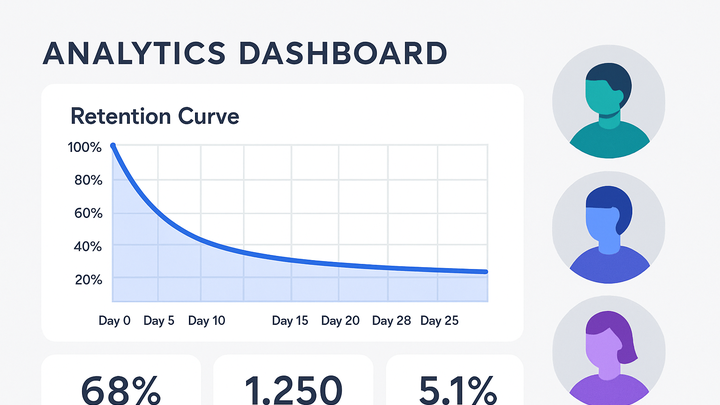Published on 2025-06-28T02:43:07Z
What is Customer Retention? Definition and Examples
Customer retention in analytics refers to the practice of measuring and improving the proportion of customers who continue using a product or service over time. It is a key indicator of customer loyalty, satisfaction, and the long-term health of a business. High retention rates typically lead to increased lifetime value (LTV), reduced acquisition costs, and more predictable revenue streams. By tracking retention, companies can identify friction points in the user experience, segment customers by behavior, and tailor strategies to keep users engaged. Analytics platforms such as Google Analytics 4 (GA4) and cookie-free solutions like plainSignal provide the data and insights needed to understand retention patterns and drive actionable improvements.
Customer retention
Percentage of customers who continue using a product over time, indicating loyalty and long-term value.
Why Customer Retention Matters
Maintaining a strong base of returning customers is essential for sustainable growth and profitability. Understanding why retention matters helps prioritize resources and optimize customer experiences.
-
Increases customer lifetime value
Retained customers make repeat purchases and use the product longer, boosting the average revenue per user over time.
-
Reduces acquisition costs
Acquiring new customers can be up to five times more expensive than retaining existing ones; improving retention lowers overall marketing spend.
-
Drives sustainable growth
High retention rates lead to more predictable revenue streams and support long-term business planning and investment.
Measuring Customer Retention
Quantifying retention involves calculating specific metrics and analyzing user cohorts to spot trends and areas for improvement.
-
Retention rate
The percentage of customers who remain active over a defined period. Calculate it as ((E - N) / S) × 100, where S = starting customers, N = new customers, and E = ending customers.
-
Churn rate
The percentage of customers lost during a time frame. It is the inverse of retention and highlights areas where customers disengage.
-
Cohort analysis
Tracks sets of users who started using the product at the same time to compare retention across different groups and time periods.
Analytics Tools for Tracking Retention
Various analytics platforms offer built-in retention reports and customizable tracking to help businesses monitor and optimize customer loyalty.
-
PlainSignal implementation
plainSignal provides a privacy-focused, cookie-free approach to tracking returning visitors and retention without relying on third-party cookies.
-
Tracking code example
<link rel="preconnect" href="//eu.plainsignal.com/" crossorigin /> <script defer data-do="yourwebsitedomain.com" data-id="0GQV1xmtzQQ" data-api="//eu.plainsignal.com" src="//cdn.plainsignal.com/plainsignal-min.js"></script> -
Privacy compliance
As a cookie-free solution, plainSignal respects user privacy and helps you stay compliant with GDPR and other data regulations.
-
-
Google analytics 4 (GA4) setup
GA4 offers advanced retention and user lifecycle reports to analyze how cohorts of users return and engage over time.
-
Enable user-id
Configure User-ID tracking to unify sessions across devices for accurate retention measurement.
-
Access retention reports
In the GA4 dashboard, navigate to ‘Life cycle’ → ‘Retention’ to view retention curves and insights.
-
Strategies to Improve Retention
Once you’ve measured retention, apply proven tactics to enhance user loyalty, reduce churn, and increase engagement over time.
-
Personalization
Tailor content, product recommendations, and communications based on user behavior and preferences to keep customers engaged.
-
Loyalty programs
Implement reward systems, points, or exclusive benefits to incentivize repeat purchases and ongoing engagement.
-
Customer feedback loops
Regularly collect, analyze, and act upon customer feedback to improve the product experience and demonstrate that you value user input.
